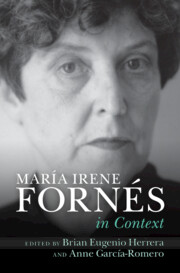Refine search
Actions for selected content:
71 results
Chapter 4 - Futurism, Dadaism, and Surrealism
- from Part I - Forms and Genres
-
-
- Book:
- The Cambridge Companion to Modernist Theatre
- Published online:
- 28 August 2025
- Print publication:
- 11 September 2025, pp 72-89
-
- Chapter
- Export citation
Epilogue
- from Part II - Themes and Issues
-
-
- Book:
- The Cambridge Companion to Modernist Theatre
- Published online:
- 28 August 2025
- Print publication:
- 11 September 2025, pp 302-312
-
- Chapter
- Export citation
Introduction
-
-
- Book:
- The Cambridge Companion to Modernist Theatre
- Published online:
- 28 August 2025
- Print publication:
- 11 September 2025, pp 1-18
-
- Chapter
- Export citation

María Irene Fornés In Context
-
- Published online:
- 27 August 2025
- Print publication:
- 07 August 2025
Chapter 19 - Avant-Gardist
- from Part III - Culture, Society, and Politics
-
-
- Book:
- María Irene Fornés In Context
- Published online:
- 27 August 2025
- Print publication:
- 07 August 2025, pp 205-215
-
- Chapter
- Export citation
Chapter 1 - Havana and New York City
- from Part I - Places and People
-
-
- Book:
- María Irene Fornés In Context
- Published online:
- 27 August 2025
- Print publication:
- 07 August 2025, pp 3-13
-
- Chapter
- Export citation
Conclusion: Reflections, Ideas, Supplements
- from Part IV - Scholarship
-
-
- Book:
- The Cambridge Companion to <i>The Rite of Spring</i>
- Published online:
- 28 June 2025
- Print publication:
- 17 July 2025, pp 285-298
-
- Chapter
- Export citation
Chapter 14 - Modeling Long-term Trends and Discontinuities in Art
- from Part III - Understanding Art Through Dynamic Models
-
- Book:
- A Complex Systems View on the Visual Arts
- Published online:
- 20 March 2025
- Print publication:
- 03 April 2025, pp 362-381
-
- Chapter
- Export citation
Rubbish, Animism and Post-Fukushima Japan
-
- Journal:
- Asia-Pacific Journal / Volume 22 / Issue 11 / November 2024
- Published online by Cambridge University Press:
- 14 March 2025, e2
-
- Article
-
- You have access
- Open access
- Export citation
3.8 - Verse II
- from History 3 - Forms
-
-
- Book:
- The New Cambridge History of Russian Literature
- Published online:
- 31 December 2024
- Print publication:
- 12 December 2024, pp 587-606
-
- Chapter
- Export citation
1.7 - Modernism and the Avant-Garde
- from History 1 - Movements
-
-
- Book:
- The New Cambridge History of Russian Literature
- Published online:
- 31 December 2024
- Print publication:
- 12 December 2024, pp 125-146
-
- Chapter
- Export citation
Chapter 35 - Avant-Garde Theatre after Pirandello
- from Part VI - Reception and Legacy
-
-
- Book:
- Pirandello in Context
- Published online:
- 14 March 2024
- Print publication:
- 21 March 2024, pp 283-290
-
- Chapter
- Export citation
Chapter 29 - An Explosive Confrontation
- from Part IV - Concepts and Legacy
-
-
- Book:
- Messiaen in Context
- Published online:
- 09 November 2023
- Print publication:
- 30 November 2023, pp 267-277
-
- Chapter
- Export citation
18 - From ‘Stereotyped Postures’ to ‘Credible Avant-Garde Strategies’
- from Part V - Modern Metal Genres
-
-
- Book:
- The Cambridge Companion to Metal Music
- Published online:
- 31 August 2023
- Print publication:
- 14 September 2023, pp 251-264
-
- Chapter
- Export citation
Chapter 2 - A Public Migrant Theatre
-
- Book:
- State of the Arts
- Published online:
- 03 August 2023
- Print publication:
- 17 August 2023, pp 68-101
-
- Chapter
- Export citation
21 - Magazines
- from Part II - Forms, Genre, and Media
-
-
- Book:
- The Cambridge History of American Modernism
- Published online:
- 13 July 2023
- Print publication:
- 20 July 2023, pp 364-380
-
- Chapter
- Export citation
20 - The Limits of an American Modernist Avant-Garde
- from Part II - Forms, Genre, and Media
-
-
- Book:
- The Cambridge History of American Modernism
- Published online:
- 13 July 2023
- Print publication:
- 20 July 2023, pp 349-363
-
- Chapter
- Export citation
20 - Perceiving Japan
- from Part III - Social Practices and Cultures in Modern Japan
-
-
- Book:
- The New Cambridge History of Japan
- Published online:
- 19 May 2023
- Print publication:
- 08 June 2023, pp 671-707
-
- Chapter
- Export citation
Chapter 6 - Art-Historical Magic Realism and Rushdie’s Twenty-First-Century Politics
- from Part II - Literary and Creative Contexts
-
-
- Book:
- Salman Rushdie in Context
- Published online:
- 23 March 2023
- Print publication:
- 30 March 2023, pp 78-93
-
- Chapter
- Export citation
Chapter 25 - Modernism and Symbolism
- from Part IV - Literature
-
-
- Book:
- Chekhov in Context
- Published online:
- 16 February 2023
- Print publication:
- 23 February 2023, pp 191-197
-
- Chapter
- Export citation
